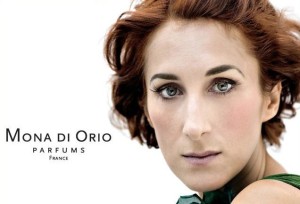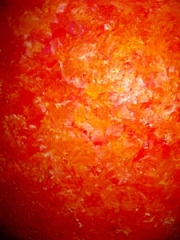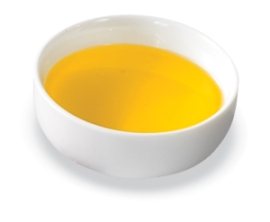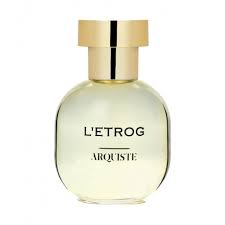Tilda Swinton has dreamed of a perfume.
That is how Etat Libre d’Orange (“ELDO”) starts to describe the perfume that they made in homage to (and in collaboration with) the talented, eccentric, British actress.
Not a girly juice, oh no. A radical fragrance that soothes the fire under the milky skin. A warm perfume, cooled by ginger. If this perfume was a light, it would be an orange glow. That’s what it is. Moreover, if you remove a letter
from the word ‘orange’, you have orage – ‘storm’ in French – and that suits her. On the surface, the elements are rousing. On the inside, the fire is tamed, it burns gently in the fireplace of her Scottish home. The fire purrs, the ginger is crystallized, the milk is warm. The room is a sanctuary. She said: I want a cozy perfume. And I hear the word ‘Cosi’ too. Comme ça. Like This. This perfume is her offering, inspired by a poem of Rumi, Like This. And in terms of this uncommon woman, I also hear: And like nothing else. It’s like this – punctuated with a bewitching smile.
 Tilda Swinton, Like This (which is also, alternatively, called “Like This,” “Like This, Tilda Swinton,” or “Like This… Tilda Swinton“) is the actress’ interpretation of her favorite Rumi poem. As she explains, she doesn’t even normally like scents in a bottle — but she adores Rumi and, now, the “cozy” comfort of her eponymous fragrance:
Tilda Swinton, Like This (which is also, alternatively, called “Like This,” “Like This, Tilda Swinton,” or “Like This… Tilda Swinton“) is the actress’ interpretation of her favorite Rumi poem. As she explains, she doesn’t even normally like scents in a bottle — but she adores Rumi and, now, the “cozy” comfort of her eponymous fragrance:
I have never been a one for scents in bottles. The great Sufi poet Rumi wrote : If anyone wants to know what «spirit» is, or what «God’s fragrance» means, lean your head toward him or her. Keep your face there close. Like this. […]
This is possibly my favourite poem of all time. It restores me like the smoke/rain/gingerbread/ greenhouse my scent-sense is fed by.
The simple feelings of “home” and nature were Ms. Swinton’s precise goal in creating the perfume — and I’m emphasizing that for two reasons: 1), because this perfume won’t be for everyone as it is quite… er… unusual; and 2) because the aromas of a kitchen are fundamental to the essence of Tilda Swinton Like This:
My favourite smells are the smells of home, the experience of the reliable recognisable after the exotic adventure: the regular – natural – turn of the seasons, simplicity and softness after the duck and dive of definition in the wide, wide world.
When Mathilde Bijaoui first asked me what my own favourite scent in a bottle might contain, I described a magic potion that I could carry with me wherever I went that would hold for me the fragrance – the spirit – of home. The warm ginger of new baking on a wood table, the immortelle of a fresh spring afternoon, the lazy sunshine of my grandfather’s summer greenhouse, woodsmoke and the whisky peat of the Scottish Highlands after rain. I told her about a bottle of spirit, something very simple, to me : something almost indescribable, so personal it should be. The miracle is that Mathilde made it.
Like This was released in 2010, and contains the following notes:
Yellow mandarin, ginger, pumpkin accord, immortelle, Moroccan neroli, rose de Grasse, vetiver, heliotrope, and musk.
Immortelle is such a key part of this perfume (and such a hugely polarizing note) that it’s worth a brief explanation for those unfamiliar with the name. As Fragrantica explains, immortelle is a flowering plant from the Southern Mediterreanean area which has the smell of either: maple syrup, caramel, fenugreek spice, curry and/or toasted bread. The essential oil “has a strongly straw-like, fruity smell, with a honey and tea undertone.”
I tested Like This three times, with slightly different outcomes for the opening and longevity. The first time, the perfume started with an airy (but strong) note of fresh, yellow citrus that almost immediately turned sweeter and more floral in nature. The overall image is that of a dry, slightly woody, yellow floral with honeyed sweetness and some dried hay undertones– which is precisely what Immortelle is like in large part. The citrus note isn’t exactly lemon, but it’s not really tangerine, either. It’s more like very honeyed lemon for the first five minutes.
Soon thereafter, Like This turned milky or lactonic with candied ginger, milky notes, light musk and an airy element of what felt like honey-sweetened vegetables. It wasn’t pumpkin, and it took me a little while to pinpoint it, but it turned out to be glazed carrots. I know Tilda Swinton Like This is supposed to evoke gingerbread houses and pumpkin but, to me, the note was definitely caramelized carrots. It’s actually a lot more attractive than it sounds, especially when combined with the floral elements.
 Less than 30 minutes in, Tilda Swinton Like This (honestly, I’m never sure what I’m supposed to call this perfume!) becomes deeper, smokier and woodier as the immortelle starts to bloom. The milky elements fade as a slightly burnt note creeps in, along with a maple syrup accord. A little over an hour later, “Like This” turns into a complete skin scent that is the immortelle’s yellow flower, along with musk over a dry woods element and the merest dusting of maple syrup. It’s all orange-yellow and brown — and that’s about it. By the second hour, I thought it had died completely. Really. It seemed to have vanished. So, I began a test on my other arm when, to my surprise, faint traces of the scent popped up on the first arm a little later before fading away completely at the four-hour mark.
Less than 30 minutes in, Tilda Swinton Like This (honestly, I’m never sure what I’m supposed to call this perfume!) becomes deeper, smokier and woodier as the immortelle starts to bloom. The milky elements fade as a slightly burnt note creeps in, along with a maple syrup accord. A little over an hour later, “Like This” turns into a complete skin scent that is the immortelle’s yellow flower, along with musk over a dry woods element and the merest dusting of maple syrup. It’s all orange-yellow and brown — and that’s about it. By the second hour, I thought it had died completely. Really. It seemed to have vanished. So, I began a test on my other arm when, to my surprise, faint traces of the scent popped up on the first arm a little later before fading away completely at the four-hour mark.
My second test started like the first with that citrus note that rapidly morphed into something sweeter and more floral. Again, the citrus was sweet and turned into tangerine around the five-minute mark, adding a soupçon of tartness under the combination of honey. Again, there were fragrant yellow flowers; candied ginger; and dry, wooded herbals that almost feel like the stems of the immortelle mixed with some hay. This time, however, there were no milky notes that evoked a sweetened, carrot chai. In contrast, there was now the definite scent of heliotrope, adding a candied violet undertone to the scent, along with very noticeable, lemon-nuanced vetiver, and the faintest hint of rose concentrate.
That rose note was a key part of both the second and third tests of Tilda Swinton Like This. It’s never a wholly distinct, individually clear note but, rather, intertwined with the carrot. I know irises can sometimes have a carrot-like undertone, but do roses or heliotrope? Perhaps it’s how the “pumpkin accord” translates to my nose when mixed in with the honeyed syrup aspects of immortelle and the roses, but I’m telling you, Tilda Swinton Like This smells of roses and yellow immortelle flowers heavily intertwined with caramelized carrots — all atop a foundation of dry woods, vetiver, and nutty, butterscotch-like, maple syrup.
 I realise it all sounds terrible. I mean, honestly, what a combination! It’s as eccentrically odd and chameleon-like as Tilda Swinton herself. And, yet, in some crazy way, it actually works. Forget about the individual notes and just think of a very sweet, but simultaneously dry, honeyed floral scent of pink roses and yellow flowers. Imagine mimosas, almost, if you want. Now, try to think that underneath that, there is something that’s a little bit like warm, sweet carrots and nutty syrup (in lieu of the usual honey). But it’s not incredibly heavy or sugary, because there are some dry, hay-like notes, a woody element and a little bit of fresh green from the vetiver. That is the essence of Tilda Swinton, Like This.
I realise it all sounds terrible. I mean, honestly, what a combination! It’s as eccentrically odd and chameleon-like as Tilda Swinton herself. And, yet, in some crazy way, it actually works. Forget about the individual notes and just think of a very sweet, but simultaneously dry, honeyed floral scent of pink roses and yellow flowers. Imagine mimosas, almost, if you want. Now, try to think that underneath that, there is something that’s a little bit like warm, sweet carrots and nutty syrup (in lieu of the usual honey). But it’s not incredibly heavy or sugary, because there are some dry, hay-like notes, a woody element and a little bit of fresh green from the vetiver. That is the essence of Tilda Swinton, Like This.
The perfume remains that way for quite a while until, finally, the dry-down starts around the third hour and “Like This” morphs into light, sheer, maple syrup with musk. Whatever happened in terms of the 2-4 hour duration during my first test didn’t repeat itself the second or third time around when “Like This” lasted 9.5 hours and 8 hours, respectively. A change in the dosage was responsible. On all three occasions, however, the perfume had incredibly moderate to low sillage during the first hour, and soon thereafter becomes a skin scent. If you don’t put on a lot and if you’re anosmic to musk, it may appear to be much more fleeting in nature than it actually is. What is a little surprising is that the perfume is moderately strong despite being an airy, sheer scent that lies right on the skin.
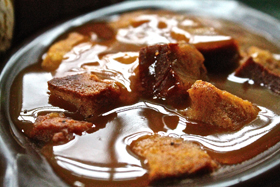
Source: The Sweet Life at TheSweetlifeonline.com. (For Pumpkin bread pudding with maple sauce recipe, click photo. Link embedded within.)
I think your skin chemistry will greatly impact how this perfume smells on you, given the unusual combination of notes and the tricky aspect of the immortelle. On me, the flowers came to the forefront with the vegetable, ginger and syrup in the background. On others, however, particularly those commenting on Fragrantica, the situation was reversed. The vast majority talked about ginger and pumpkin up front, with the flowers nestled in the background. A good number also found the perfume to be primarily orange and/or ginger, with pumpkin not being so dominant. A few mentioned the immortelle as a floral note, (as opposed to immortelle manifesting itself as maple syrup), and a handful found that the heliotrope and vetiver were also dominant. Some of the comments may be helpful:
- Upon first spray, the floral notes (heliotrope particularly) and spices are in equal balance, but as the perfume settles on my skin, the ginger, pumpkin, and immortelle become the stars of the show for several hours. [¶] Toward the end of the dry-down, Like This becomes a feminine, honeyed floral (yes, the floral notes re-emerge!). It is reminiscent of Annick Goutal’s Sables at this stage (an immortelle soliflore), but lighter and less syrupy. And finally, a hint of earthy, slightly leathery vetiver emerges. What a gorgeous ride this one takes you on!
- The orange-ginger combination does give this fragrance a hint of just baked gingerbread, but dominant immortelle neutralises the sweetness and makes it too herbal to become a foodie dessert scent. I don’t get any pumpkin at all, not much rose either. Vetyver is another prominent note, along with clean musk make Like This a perfect unisex scent […]
- Even though I don’t pick up any of the pumpkin (which was what intrigued me from the reviews) it is absolute magic on my skin. I thought that freesia was my favorite floral, then I thought it was peony, then rose…now I’m certain it’s actually immortelle. LIKE THIS begins so incredibly with the immortelle, and as it dries down the tangerine and the heliotrope & ginger show in stunning form. I ordered a FB within minutes of putting this on.
- Very light and grassy in a dried way, with a feeling of milky coffee in the back. I really wanted to smell pumpkin, but I don’t really detect that on my skin. The ginger and tangerine are just faintly there, as additions rather than strong presence, and overall it’s a nice but strange scent. It’s a mood almost more than a perfume.
I chose those comments to show you that Like This isn’t perhaps as gourmand as you may think from the description and notes. And, yet, there are plenty who find it very “foodie” — though they seem to be quite enamoured as well. As I said up above, it will really depend on how you feel about immortelle and how it manifests with your particular skin chemistry.
Those who shudder at the very thought of the note may want to consider The Perfume Posse‘s impressions of the scent:
it starts off a little citrus-ish, the ginger and heliotrope waves some flags to let you know it’s not gonna be like that. There’s a little bit of a tinnish feel in the open. And then the nutty pancake syrupy immortelle buzzes – not loud, soft and wafty, like a smoky tendril. The tin is gone, and it starts warming up in some fabulous ways that make my toes curl. I’m not sure I get pumpkin exactly, but there is this pulpy-ness blended into the immortelle that feels like pumpkin with some spice. Pumpkin pie, almonds and pancake syrup without the calories or sweetness. But it’s not really foody. Gourmand quality to it, but just not that. It’s warmer, richer, but completely light and wispy. I would … [never] believe a perfume with this list of notes would be light and floaty. But it is. Warm, rich, light, floaty and a great big soft hug.
I tried Like This three times in part because I couldn’t decide how I felt about it. (Plus, what initially seemed to be a 2 hour duration in the first test made it easier.) And I’m still ambivalent. It’s definitely intriguing and it also really grows on you! I love the floral aspects of it on me, including the yellowness of the immortelle. And, honestly, that rose concentrate backed by sweet carrots is pretty damn cool! I’m less crazy about the flower’s maple syrup undertone as it manifests itself here. I know I wouldn’t wear Like This if it was primarily pumpkin, ginger, and maple syrup — but that is not what it is on me. However, that is precisely how it appears on a large number of people, so clearly this is a perfume that needs testing (on your actual skin) before purchase. For myself, I don’t think I would ever buy “Like This.” But if a decant or bottle fell into my lap, I would wear it. On occasion….
I think…





